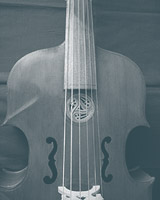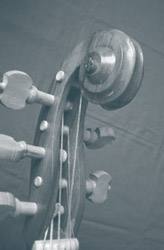A Viola Da What?!? by Margaret Little
/ May 5, 2003
Version française...
 Although it is usually packed in a cello-like
travel case, the viola Da Gamba, once it sheds this outer shell, is quite a
different animal! Although it is usually packed in a cello-like
travel case, the viola Da Gamba, once it sheds this outer shell, is quite a
different animal!
First of all, these two
instruments come from very different backgrounds. While the violin and cello
served to enliven plebeian street festivities, the viol was the instrument par
excellence of the nobility and flourished in the courts and noble households of
Europe during the seventeenth and eighteenth centuries. A chest of viols
(treble, tenor and bass) was a common accessory in any aristocratic household
where playing in consort or improvising divisions on a bass, for the virtuosi,
would have been one of the most beloved forms of entertainment. The violin
family, on the other hand (violin, viola, cello and double-bass), was not
welcomed in the courts for a long time, because it was considered vulgar and
unrefined! This attitude of course changed completely over time.
The viola da gamba (held between the legs) differs from the viola da
braccia (held in the arms) in several ways. All sizes of viols, from
small to large, are held between the legs, fretted like the guitar and bowed
"underhand." The instrument itself has a carved belly but a flat back, bent at
the shoulders. The f holes are usually in a C shape, the sides are glued right to
the edge of the belly and back, making repairs more of a nightmare for violin
makers. The shoulders are sloped rather than rounded, the finger board and
bridge are wider and flatter in order to accommodate six or seven strings (the
seventh string was added by Sainte-Colombe in France).
Another important feature: while
cellos have beautiful scrolls, viols have beautifully carved heads. Depending on
how rich the viol player, you could get incredibly ornate instruments with
intricate carving and inlays, and exotic wood strips on the back.
What about the bow? There are
different models, depending on countries and periods; sometimes they are quite
similar to baroque cello bows.
Learning the viol
What about learning the viol?
How does it compare to the cello? Well, if your viol is well tuned, as well as
your frets, you've got at least one problem solved: you might be able to play in
tune without too much difficulty! And then there is a lot of easy repertoire to
share with other viol friends; beautiful English consort music to delight
oneself with for years. There is also a very challenging and virtuoso repertoire
for the bold and an unlimited opportunity for all sorts of chamber
music.
A few useful tips for beginners: 
"Being conveniently seated, place your Viol decently betwixt your knees."
(Christopher Simpson, The Division Viol, 1667)
"Arm yourself with Preparative Resolutions to gain a
Handsome-Sweet-Smart-Clear-Stroak; or else Play not at all: for your Viol be
never so Good, if you have an Unhandsom-Harsh-Rugged-Scratching-Scraping-Stroak,
(as too many have) your Viol will seem Bad, and your Play Worse." (Thomas Mace,
Musick's Monument, 1676)
But then, some people did arm themselves with "Preparative
Resolutions" and inspired Jean Rousseau, in his Traité de la viole in
1687 to say, ". . . the human Voice . . . never has an Instrument imitated it as
well as the Viol."
This quote inspired Susie Napper
and Margaret Little to call their viola da gamba ensemble "Les Voix Humaines."
Their concert series is devoted to viola da gamba repertoire of different
periods and countries.
Next Voix Humaines concert: Thursday May 15, 2003 at 8:00 pm at the
Chapelle Notre-Dame de Bon-Secours. "Vanitate Mundi" (Missa pro defunctis and
motets by Pierre Bouteiller) with soprano Suzie LeBlanc, Belgian tenor Stephan
Van Dyck, Susie Napper and Margaret Little on viols, Alex Weiman at the organ,
and Sylvain Bergeron on theorbo. See
www.lesvoixhumaines.org.
Version française... | 

